Paper Menu >>
Journal Menu >>
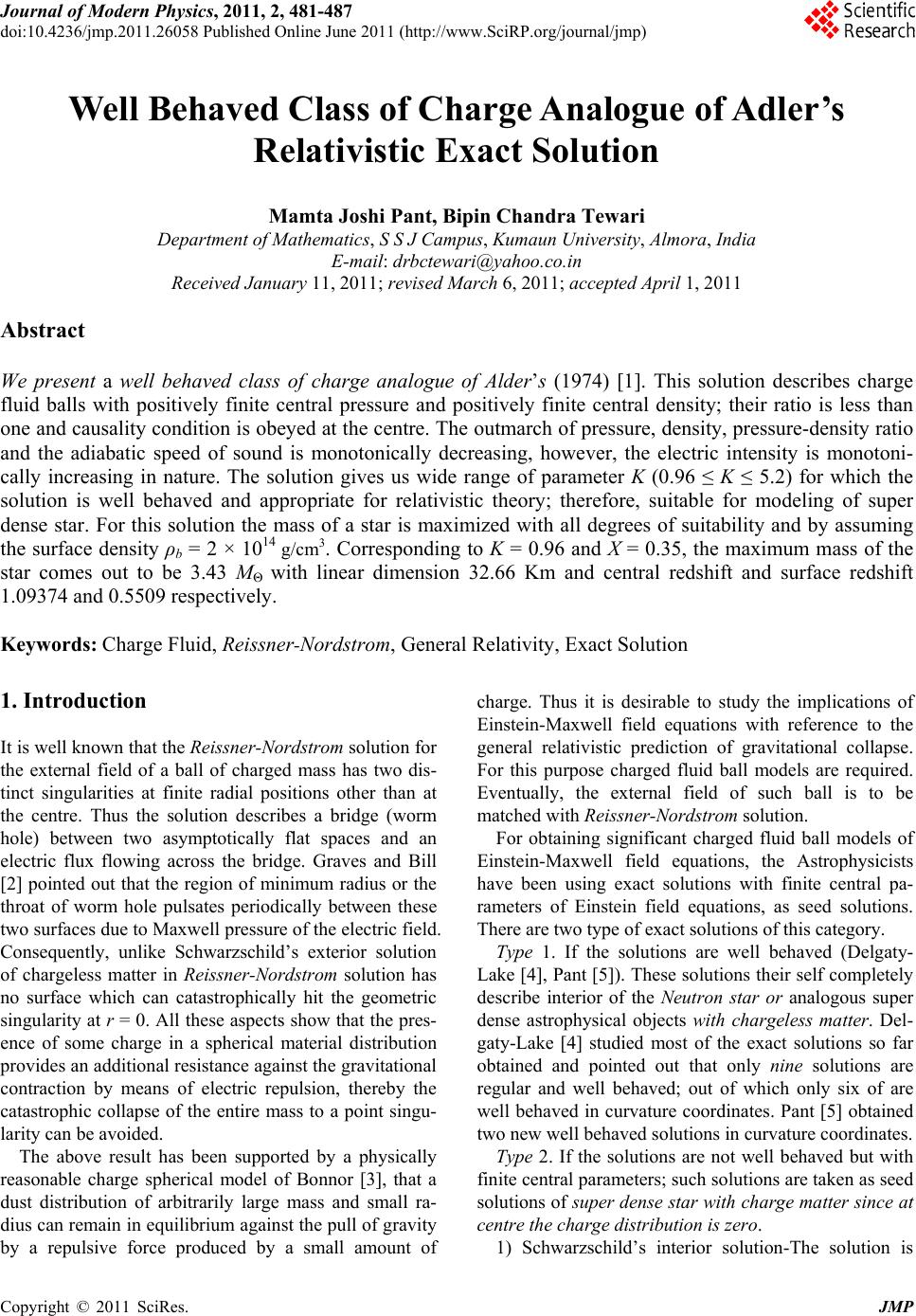 Journal of Modern Physics, 2011, 2, 481-487 doi:10.4236/jmp.2011.26058 Published Online June 2011 (http://www.SciRP.org/journal/jmp) Copyright © 2011 SciRes. JMP Well Behaved Class of Charge Analogue of Adler’s Relativistic Exact Solution Mamta Joshi Pant, Bipin Chandra Tewari Department of Mathematics, S S J Campus, Kumaun University, Almora, India E-mail: drbctewari@yahoo.co.in Received January 11, 2011; revised March 6, 2011; accepted April 1, 2011 Abstract We present a well behaved class of charge analogue of Alder’s (1974) [1]. This solution describes charge fluid balls with positively finite central pressure and positively finite central density; their ratio is less than one and causality condition is obeyed at the centre. The outmarch of pressure, density, pressure-density ratio and the adiabatic speed of sound is monotonically decreasing, however, the electric intensity is monotoni- cally increasing in nature. The solution gives us wide range of parameter K (0.96 ≤ K ≤ 5.2) for which the solution is well behaved and appropriate for relativistic theory; therefore, suitable for modeling of super dense star. For this solution the mass of a star is maximized with all degrees of suitability and by assuming the surface density ρb = 2 × 1014 g/cm3. Corresponding to K = 0.96 and X = 0.35, the maximum mass of the star comes out to be 3.43 MΘ with linear dimension 32.66 Km and central redshift and surface redshift 1.09374 and 0.5509 respectively. Keywords: Charge Fluid, Reissner-Nordstrom, General Relativity, Exact Solution 1. Introduction It is well known that the Reissner-Nordstrom solution for the external field of a ball of charged mass has two dis- tinct singularities at finite radial positions other than at the centre. Thus the solution describes a bridge (worm hole) between two asymptotically flat spaces and an electric flux flowing across the bridge. Graves and Bill [2] pointed out that the region of minimum radius or the throat of worm hole pulsates periodically between these two surfaces due to Maxwell pressure of the electric field. Consequently, unlike Schwarzschild’s exterior solution of chargeless matter in Reissner-Nordstrom solution has no surface which can catastrophically hit the geometric singularity at r = 0. All these aspects show that the pres- ence of some charge in a spherical material distribution provides an additional resistance against the gravitational contraction by means of electric repulsion, thereby the catastrophic collapse of the entire mass to a point singu- larity can be avoided. The above result has been supported by a physically reasonable charge spherical model of Bonnor [3], that a dust distribution of arbitrarily large mass and small ra- dius can remain in equilibrium against the pull of gravity by a repulsive force produced by a small amount of charge. Thus it is desirable to study the implications of Einstein-Maxwell field equations with reference to the general relativistic prediction of gravitational collapse. For this purpose charged fluid ball models are required. Eventually, the external field of such ball is to be matched with Reissner-Nordstrom solution. For obtaining significant charged fluid ball models of Einstein-Maxwell field equations, the Astrophysicists have been using exact solutions with finite central pa- rameters of Einstein field equations, as seed solutions. There are two type of exact solutions of this category. Type 1. If the solutions are well behaved (Delgaty- Lake [4], Pant [5]). These solutions their self completely describe interior of the Neutron star or analogous super dense astrophysical objects with chargeless matter. Del- gaty-Lake [4] studied most of the exact solutions so far obtained and pointed out that only nine solutions are regular and well behaved; out of which only six of are well behaved in curvature coordinates. Pant [5] obtained two new well behaved solutions in curvature coordinates. Type 2. If the solutions are not well behaved but with finite central parameters; such solutions are taken as seed solutions of super dense star with charge matter since at centre the charge distribution is zero. 1) Schwarzschild’s interior solution-The solution is 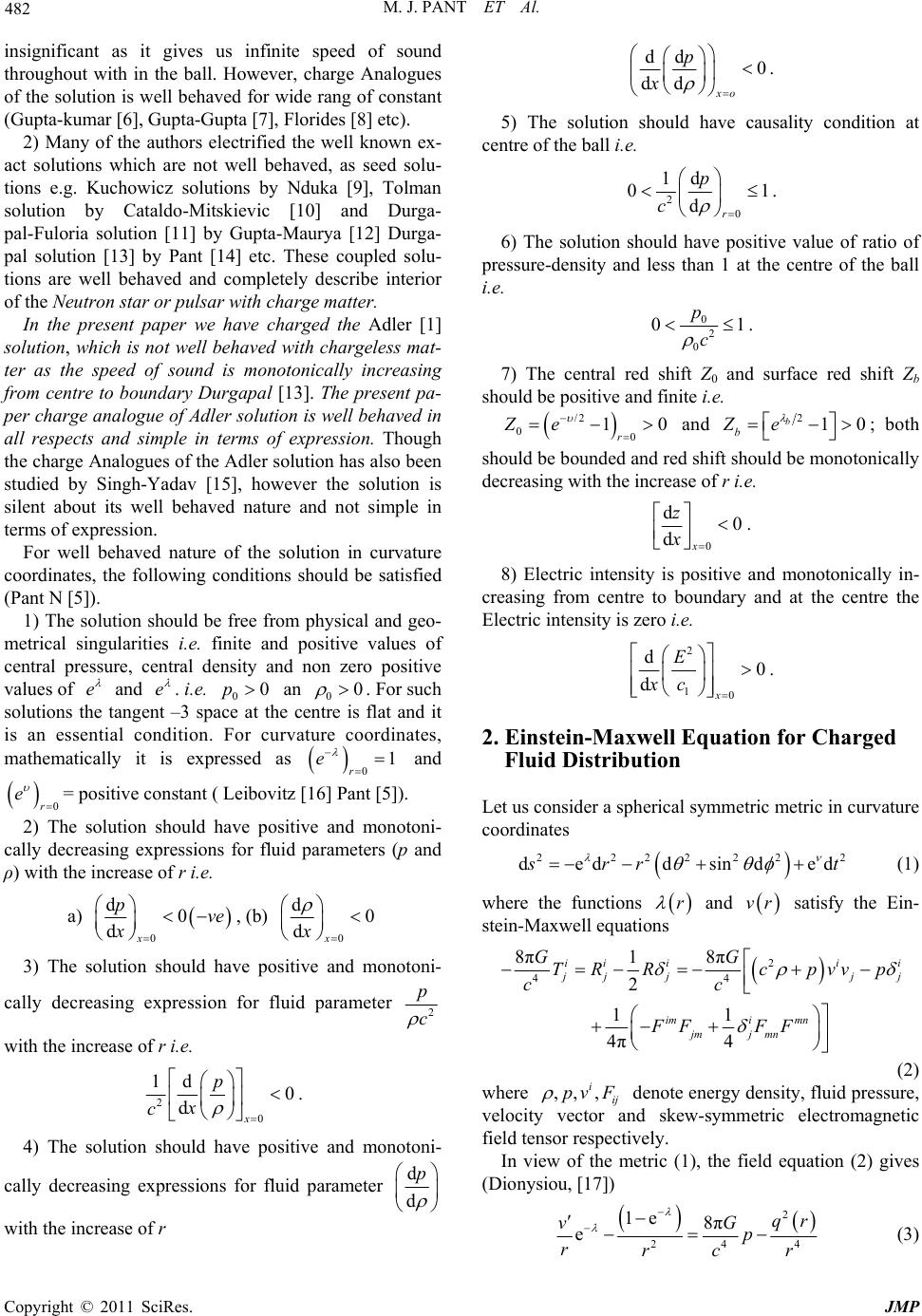 M. J. PANT ET Al. Copyright © 2011 SciRes. JMP 482 insignificant as it gives us infinite speed of sound throughout with in the ball. However, charge Analogues of the solution is well behaved for wide rang of constant (Gupta-kumar [6], Gupta-Gupta [7], Florides [8] etc). 2) Many of the authors electrified the well known ex- act solutions which are not well behaved, as seed solu- tions e.g. Kuchowicz solutions by Nduka [9], Tolman solution by Cataldo-Mitskievic [10] and Durga- pal-Fuloria solution [11] by Gupta-Maurya [12] Durga- pal solution [13] by Pant [14] etc. These coupled solu- tions are well behaved and completely describe interior of the Neutron star or pulsar with charge matter. In the present paper we have charged the Adler [1] solution, which is not well behaved with chargeless mat- ter as the speed of sound is monotonically increasing from centre to boundary Durgapal [13]. The present pa- per charge analogue of Adler solution is well behaved in all respects and simple in terms of expression. Though the charge Analogues of the Adler solution has also been studied by Singh-Yadav [15], however the solution is silent about its well behaved nature and not simple in terms of expression. For well behaved nature of the solution in curvature coordinates, the following conditions should be satisfied (Pant N [5]). 1) The solution should be free from physical and geo- metrical singularities i.e. finite and positive values of central pressure, central density and non zero positive values of e and e . i.e. 00p an 00 . For such solutions the tangent –3 space at the centre is flat and it is an essential condition. For curvature coordinates, mathematically it is expressed as 01 r e and 0r e = positive constant ( Leibovitz [16] Pant [5]). 2) The solution should have positive and monotoni- cally decreasing expressions for fluid parameters (p and ρ) with the increase of r i.e. a) 0 d0 dx pve x , (b) 0 d0 dx x 3) The solution should have positive and monotoni- cally decreasing expression for fluid parameter 2 p c with the increase of r i.e . 2 0 1d 0 dx p x c . 4) The solution should have positive and monotoni- cally decreasing expressions for fluid parameter d d p with the increase of r dd 0 dd xo p x . 5) The solution should have causality condition at centre of the ball i.e. 2 0 1d 01 dr p c . 6) The solution should have positive value of ratio of pressure-density and less than 1 at the centre of the ball i.e. 0 2 0 01 p c . 7) The central red shift Z0 and surface red shift Zb should be positive and finite i.e. /2 00 10 r Ze and 210 b b Ze ; both should be bounded and red shift should be monotonically decreasing with the increase of r i.e. 0 d0 dx z x . 8) Electric intensity is positive and monotonically in- creasing from centre to boundary and at the centre the Electric intensity is zero i.e. 2 10 d0 dx E xc . 2. Einstein-Maxwell Equat i o n f o r C h ar g e d Fluid Distribution Let us consider a spherical symmetric metric in curvature coordinates 2222222 ded dsinded s rr t (1) where the functions r and vr satisfy the Ein- stein-Maxwell equations 2 44 8π18π 2 11 4π4 iiii i j jj jj imi mn jmj mn GG TR Rc pvvp cc FF FF (2) where ,, , i ij pv F denote energy density, fluid pressure, velocity vector and skew-symmetric electromagnetic field tensor respectively. In view of the metric (1), the field equation (2) gives (Dionysiou, [17]) 2 24 4 1e 8π eqr vG p rrc r (3) 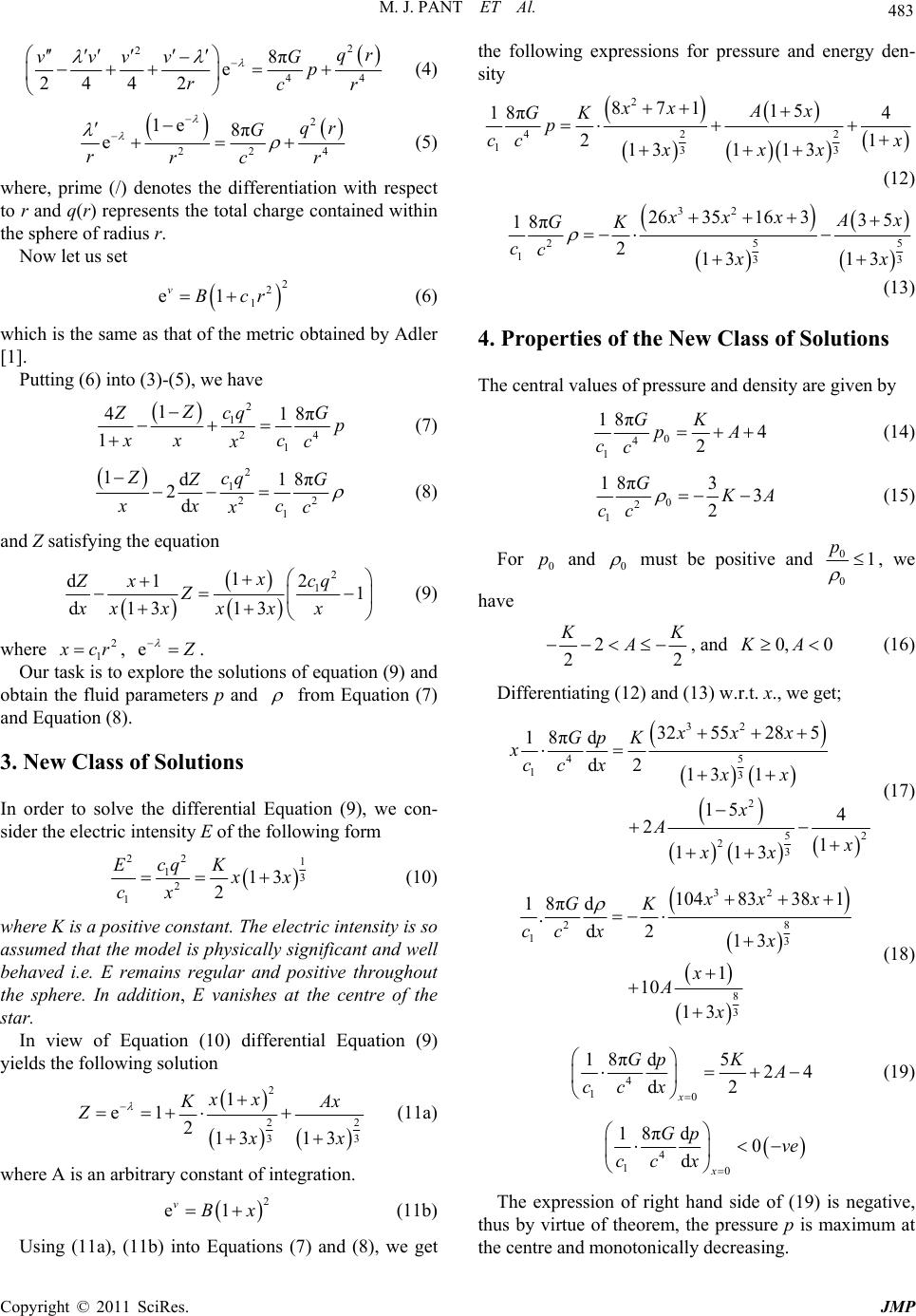 M. J. PANT ET Al. Copyright © 2011 SciRes. JMP 483 2 2 44 8π e 24 42 qr vvvv G p rcr (4) 2 22 4 1e 8π eqr G rrcr (5) where, prime (/) denotes the differentiation with respect to r and q(r) represents the total charge contained within the sphere of radius r. Now let us set 2 2 1 e1 vBcr (6) which is the same as that of the metric obtained by Adler [1]. Putting (6) into (3)-(5), we have 2 1 24 1 1 418π 1 Zcq Z Gp xx c xc (7) 2 1 22 1 1d18π 2d Zcq Z G xx c xc (8) and Z satisfying the equation 2 1 12 d1 1 d13 13 xcq Zx Z xxxxxx (9) where 2 1 x cr, e Z . Our task is to explore the solutions of equation (9) and obtain the fluid parameters p and from Equation (7) and Equation (8). 3. New Class of Solutions In order to solve the differential Equation (9), we con- sider the electric intensity E of the following form 2 21 13 2 1 13 2 cq EK x x cx (10) where K is a positive constant. The electric intensity is so assumed that the model is physically significant and well behaved i.e. E remains regular and positive throughout the sphere. In addition, E vanishes at the centre of the star. In view of Equation (10) differential Equation (9) yields the following solution 2 22 33 1 e1 213 13 xx K Ax Z x x (11a) where A is an arbitrary constant of integration. 2 e1 vBx (11b) Using (11a), (11b) into Equations (7) and (8), we get the following expressions for pressure and energy den- sity 2 422 133 87115 18π4 21 13113 xx Ax GK p cx cxxx (12) 32 255 133 263516 335 18π 213 13 xxx A x GK cc x x (13) 4. Properties of the New Class of Solutions The central values of pressure and density are given by 0 4 1 18π4 2 GK pA cc (14) 0 2 1 18π33 2 G K A cc (15) For 0 p and 0 must be positive and 0 0 1 p , we have 2 22 K K A , and 0, 0KA (16) Differentiating (12) and (13) w.r.t. x., we get; 32 45 13 2 52 23 325528 5 18πd d2 13 1 15 4 2 1 113 xxx Gp K xcx cxx x A x xx (17) 32 28 13 8 3 1048338 1 18πd .d2 13 1 10 13 xxx GK cx cx x A x (18) 4 10 18πd5 24 d2 x GpK A cx c (19) 4 10 18πd0 dx Gp ve cx c The expression of right hand side of (19) is negative, thus by virtue of theorem, the pressure p is maximum at the centre and monotonically decreasing. 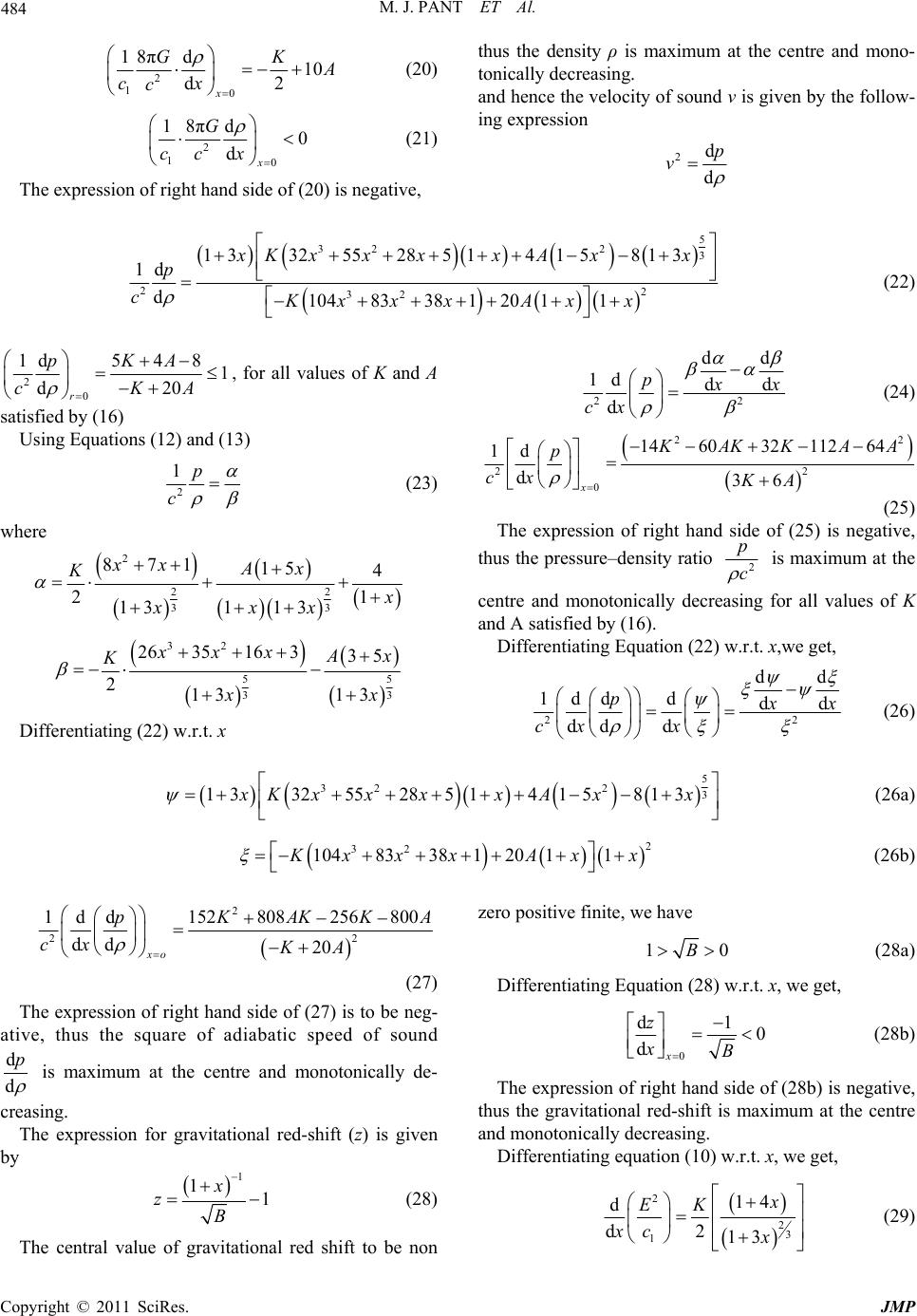 M. J. PANT ET Al. Copyright © 2011 SciRes. JMP 484 2 10 18πd10 d2 x GK A cx c (20) 2 10 18πd0 dx G cx c (21) The expression of right hand side of (20) is negative, thus the density ρ is maximum at the centre and mono- tonically decreasing. and hence the velocity of sound v is given by the follow- ing expression 2d d p v 5 322 3 22 32 1 33255285 1415813 1d d1048338120 11 xK xxxxAxx p cKx xxAxx (22) 2 0 1d548 1 d20 r pKA KA c , for all values of K and A satisfied by (16) Using Equations (12) and (13) 2 1p c (23) where 2 22 33 871154 21 131 13 xx Ax K x xxx 32 55 33 263516335 21313 xxx A x K x x Differentiating (22) w.r.t. x 22 dd 1d dd d p x x x c (24) 22 22 0 146032112 64 1d d36 x KAKKAA p x cKA (25) The expression of right hand side of (25) is negative, thus the pressure–density ratio 2 p c is maximum at the centre and monotonically decreasing for all values of K and A satisfied by (16). Differentiating Equation (22) w.r.t. x,we get, 22 dd 1dd ddd ddd p x x xx c (26) 5 322 3 1332552851415813xK xxxxAxx (26a) 2 32 1048338120 11 K xxxAxx (26b) 2 22 1dd152808256800 dd 20 xo pK AKKA x cKA (27) The expression of right hand side of (27) is to be neg- ative, thus the square of adiabatic speed of sound d d p is maximum at the centre and monotonically de- creasing. The expression for gravitational red-shift (z) is given by 1 11 x zB (28) The central value of gravitational red shift to be non zero positive finite, we have 10B (28a) Differentiating Equation (28) w.r.t. x, we get, 0 d1 0 dx z xB (28b) The expression of right hand side of (28b) is negative, thus the gravitational red-shift is maximum at the centre and monotonically decreasing. Differentiating equation (10) w.r.t. x, we get, 2 23 1 14 d d2 13 x EK xc x (29) 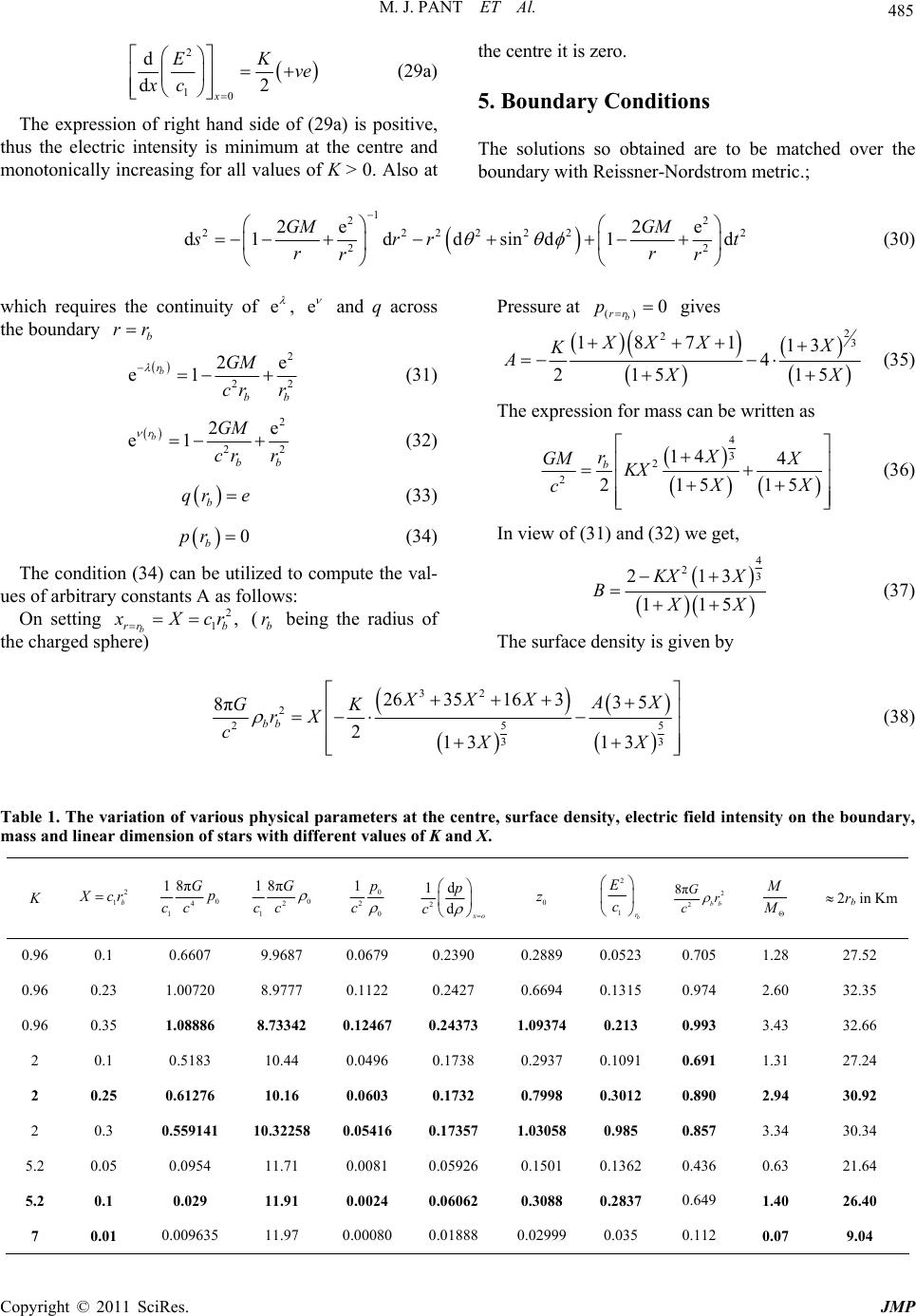 M. J. PANT ET Al. Copyright © 2011 SciRes. JMP 485 2 10 d d2 x EK ve xc (29a) The expression of right hand side of (29a) is positive, thus the electric intensity is minimum at the centre and monotonically increasing for all values of K > 0. Also at the centre it is zero. 5. Boundary Conditions The solutions so obtained are to be matched over the boundary with Reissner-Nordstrom metric.; 1 22 2222222 22 2e 2e d1d dsind1d GM GM s rr t rr rr (30) which requires the continuity of e , e and q across the boundary b rr 2 22 2e e1 b r bb GM cr r (31) 2 22 2e e1 b r bb GM cr r (32) b qr e (33) 0 b pr (34) The condition (34) can be utilized to compute the val- ues of arbitrary constants A as follows: On setting 2 1, b rr b x Xcr (b r being the radius of the charged sphere) Pressure at () 0 b rr p gives 2 23 187113 4 215 15 XX XX K A X X (35) The expression for mass can be written as 4 3 2 2 14 4 21515 bX r GM X KX X X c (36) In view of (31) and (32) we get, 4 23 213 115 K XX B X X (37) The surface density is given by 32 2 255 33 263516 335 8π 213 13 bb XXX A X GK rX cXX (38) Table 1. The variation of various physic al parameters at the centre, surface density, electric field intensity on the boundary, mass and linear dimension of stars with different values of K and X. K 2 1b Xcr 0 4 1 18πG p cc 0 2 1 18πG cc 0 2 0 1 p c 2 1d d x o p c 0 z 2 1b r E c 2 2 8π bb Gr c Μ M 2rb in Km 0.96 0.1 0.6607 9.9687 0.0679 0.2390 0.2889 0.0523 0.705 1.28 27.52 0.96 0.23 1.00720 8.9777 0.1122 0.2427 0.6694 0.1315 0.974 2.60 32.35 0.96 0.35 1.08886 8.73342 0.12467 0.24373 1.09374 0.213 0.993 3.43 32.66 2 0.1 0.5183 10.44 0.0496 0.1738 0.2937 0.1091 0.691 1.31 27.24 2 0.25 0.61276 10.16 0.0603 0.1732 0.7998 0.3012 0.890 2.94 30.92 2 0.3 0.559141 10.32258 0.05416 0.17357 1.03058 0.985 0.857 3.34 30.34 5.2 0.05 0.0954 11.71 0.0081 0.05926 0.1501 0.1362 0.436 0.63 21.64 5.2 0.1 0.029 11.91 0.0024 0.06062 0.3088 0.2837 0.649 1.40 26.40 7 0.01 0.009635 11.97 0.00080 0.01888 0.02999 0.035 0.112 0.07 9.04 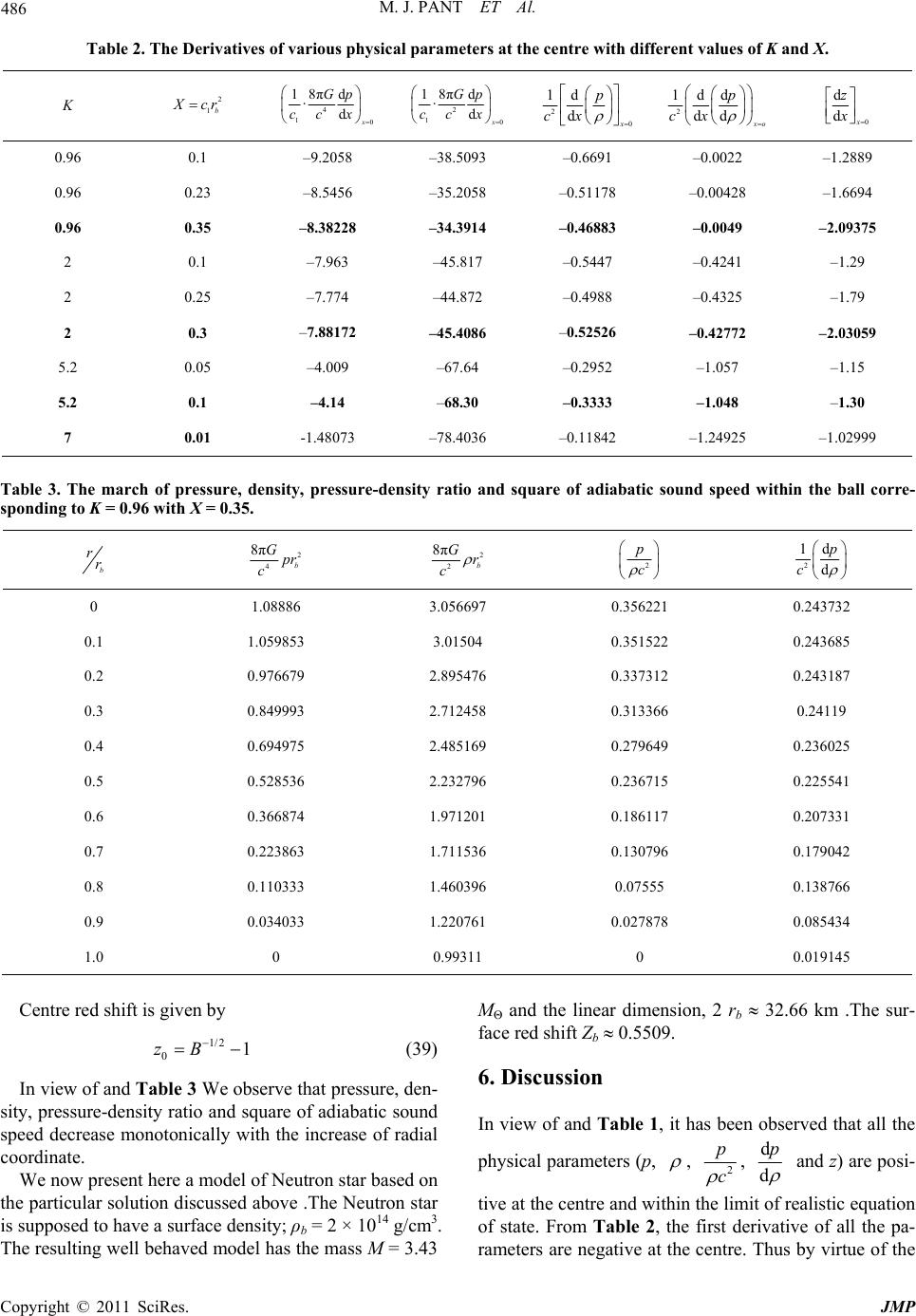 M. J. PANT ET Al. Copyright © 2011 SciRes. JMP 486 Table 2. The Derivatives of various physical parameters at the centre with different values of K and X. K 2 1b Xcr 4 10 18πd dx Gp cc x 2 10 18πd dx Gp cc x 2 0 1d dx p cx 2 1dd dd x o p cx 0 d dx z x 0.96 0.1 –9.2058 –38.5093 –0.6691 –0.0022 –1.2889 0.96 0.23 –8.5456 –35.2058 –0.51178 –0.00428 –1.6694 0.96 0.35 –8.38228 –34.3914 –0.46883 –0.0049 –2.09375 2 0.1 –7.963 –45.817 –0.5447 –0.4241 –1.29 2 0.25 –7.774 –44.872 –0.4988 –0.4325 –1.79 2 0.3 –7.88172 –45.4086 –0.52526 –0.42772 –2.03059 5.2 0.05 –4.009 –67.64 –0.2952 –1.057 –1.15 5.2 0.1 –4.14 –68.30 –0.3333 –1.048 –1.30 7 0.01 -1.48073 –78.4036 –0.11842 –1.24925 –1.02999 Table 3. The march of pressure, density, pressure-density ratio and square of adiabatic sound speed within the ball corre- sponding to K = 0.96 with X = 0.35. b rr 2 4 8π b G p r c 2 2 8π b Gr c 2 p c 2 1d d p c 0 1.08886 3.056697 0.356221 0.243732 0.1 1.059853 3.01504 0.351522 0.243685 0.2 0.976679 2.895476 0.337312 0.243187 0.3 0.849993 2.712458 0.313366 0.24119 0.4 0.694975 2.485169 0.279649 0.236025 0.5 0.528536 2.232796 0.236715 0.225541 0.6 0.366874 1.971201 0.186117 0.207331 0.7 0.223863 1.711536 0.130796 0.179042 0.8 0.110333 1.460396 0.07555 0.138766 0.9 0.034033 1.220761 0.027878 0.085434 1.0 0 0.99311 0 0.019145 Centre red shift is given by 1/2 01zB (39) In view of and Table 3 We observe that pressure, den- sity, pressure-density ratio and square of adiabatic sound speed decrease monotonically with the increase of radial coordinate. We now present here a model of Neutron star based on the particular solution discussed above .The Neutron star is supposed to have a surface density; ρb = 2 × 1014 g/cm3. The resulting well behaved model has the mass M = 3.43 MΘ and the linear dimension, 2 rb 32.66 km .The sur- face red shift Zb 0.5509. 6. Discussion In view of and Table 1, it has been observed that all the physical parameters (p, , 2 p c , d d p and z) are posi- tive at the centre and within the limit of realistic equation of state. From Table 2, the first derivative of all the pa- rameters are negative at the centre. Thus by virtue of the 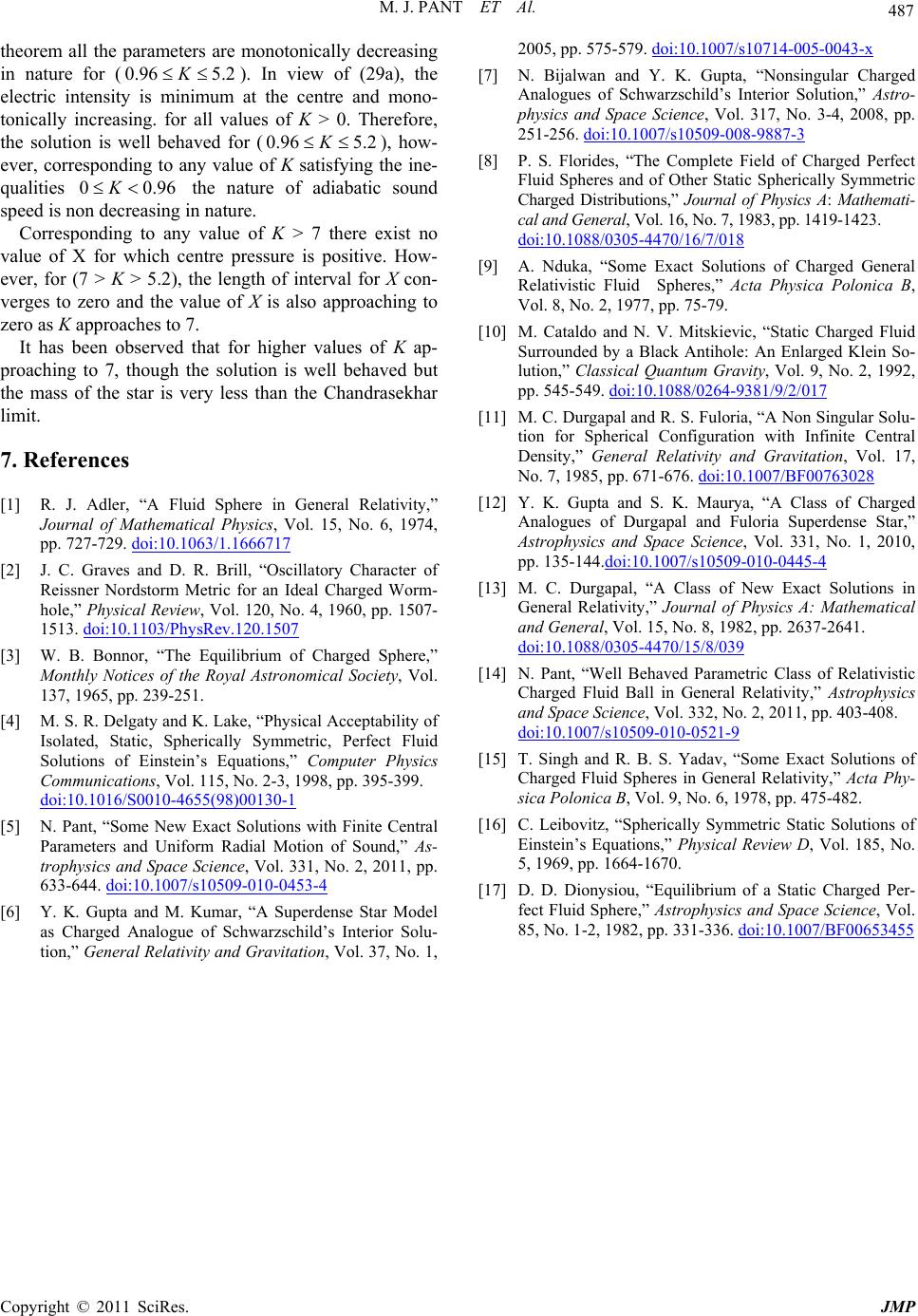 M. J. PANT ET Al. Copyright © 2011 SciRes. JMP 487 theorem all the parameters are monotonically decreasing in nature for (0.96 5.2K ). In view of (29a), the electric intensity is minimum at the centre and mono- tonically increasing. for all values of K > 0. Therefore, the solution is well behaved for (0.96 5.2K), how- ever, corresponding to any value of K satisfying the ine- qualities 00.96K the nature of adiabatic sound speed is non decreasing in nature. Corresponding to any value of K > 7 there exist no value of X for which centre pressure is positive. How- ever, for (7 > K > 5.2), the length of interval for X con- verges to zero and the value of X is also approaching to zero as K approaches to 7. It has been observed that for higher values of K ap- proaching to 7, though the solution is well behaved but the mass of the star is very less than the Chandrasekhar limit. 7. References [1] R. J. Adler, “A Fluid Sphere in General Relativity,” Journal of Mathematical Physics, Vol. 15, No. 6, 1974, pp. 727-729. doi:10.1063/1.1666717 [2] J. C. Graves and D. R. Brill, “Oscillatory Character of Reissner Nordstorm Metric for an Ideal Charged Worm- hole,” Physical Review, Vol. 120, No. 4, 1960, pp. 1507- 1513. doi:10.1103/PhysRev.120.1507 [3] W. B. Bonnor, “The Equilibrium of Charged Sphere,” Monthly Notices of the Royal Astronomical Society, Vol. 137, 1965, pp. 239-251. [4] M. S. R. Delgaty and K. Lake, “Physical Acceptability of Isolated, Static, Spherically Symmetric, Perfect Fluid Solutions of Einstein’s Equations,” Computer Physics Communications, Vol. 115, No. 2-3, 1998, pp. 395-399. doi:10.1016/S0010-4655(98)00130-1 [5] N. Pant, “Some New Exact Solutions with Finite Central Parameters and Uniform Radial Motion of Sound,” As- trophysics and Space Science, Vol. 331, No. 2, 2011, pp. 633-644. doi:10.1007/s10509-010-0453-4 [6] Y. K. Gupta and M. Kumar, “A Superdense Star Model as Charged Analogue of Schwarzschild’s Interior Solu- tion,” General Relativity and Gravitation, Vol. 37, No. 1, 2005, pp. 575-579. doi:10.1007/s10714-005-0043-x [7] N. Bijalwan and Y. K. Gupta, “Nonsingular Charged Analogues of Schwarzschild’s Interior Solution,” Astro- physics and Space Science, Vol. 317, No. 3-4, 2008, pp. 251-256. doi:10.1007/s10509-008-9887-3 [8] P. S. Florides, “The Complete Field of Charged Perfect Fluid Spheres and of Other Static Spherically Symmetric Charged Distributions,” Journal of Physics A: Mathemati- cal and General, Vol. 16, No. 7, 1983, pp. 1419-1423. doi:10.1088/0305-4470/16/7/018 [9] A. Nduka, “Some Exact Solutions of Charged General Relativistic Fluid Spheres,” Acta Physica Polonica B, Vol. 8, No. 2, 1977, pp. 75-79. [10] M. Cataldo and N. V. Mitskievic, “Static Charged Fluid Surrounded by a Black Antihole: An Enlarged Klein So- lution,” Classical Quantum Gravity, Vol. 9, No. 2, 1992, pp. 545-549. doi:10.1088/0264-9381/9/2/017 [11] M. C. Durgapal and R. S. Fuloria, “A Non Singular Solu- tion for Spherical Configuration with Infinite Central Density,” General Relativity and Gravitation, Vol. 17, No. 7, 1985, pp. 671-676. doi:10.1007/BF00763028 [12] Y. K. Gupta and S. K. Maurya, “A Class of Charged Analogues of Durgapal and Fuloria Superdense Star,” Astrophysics and Space Science, Vol. 331, No. 1, 2010, pp. 135-144.doi:10.1007/s10509-010-0445-4 [13] M. C. Durgapal, “A Class of New Exact Solutions in General Relativity,” Journal of Physics A: Mathematical and General, Vol. 15, No. 8, 1982, pp. 2637-2641. doi:10.1088/0305-4470/15/8/039 [14] N. Pant, “Well Behaved Parametric Class of Relativistic Charged Fluid Ball in General Relativity,” Astrophysics and Space Science, Vol. 332, No. 2, 2011, pp. 403-408. doi:10.1007/s10509-010-0521-9 [15] T. Singh and R. B. S. Yadav, “Some Exact Solutions of Charged Fluid Spheres in General Relativity,” Acta Phy- sica Polonica B, Vol. 9, No. 6, 1978, pp. 475-482. [16] C. Leibovitz, “Spherically Symmetric Static Solutions of Einstein’s Equations,” Physical Review D, Vol. 185, No. 5, 1969, pp. 1664-1670. [17] D. D. Dionysiou, “Equilibrium of a Static Charged Per- fect Fluid Sphere,” Astrophysics and Space Science, Vol. 85, No. 1-2, 1982, pp. 331-336. doi:10.1007/BF00653455 |

